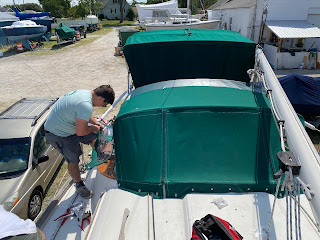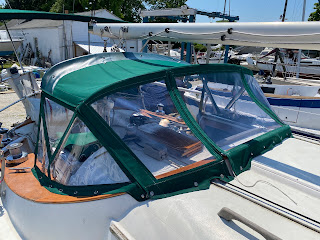I love sewing. Everything about it; the fabrics, the machinery, the design choices. Years ago I developed an obsession with vintage sewing machines, which I indulged by buying numerous old Singers on Ebay and Craigslist. I have pared down my collection somewhat, but I still have an army of them, including three hand cranks and a treadle. I also have a set of machines that I actually use; two industrial machines, three computerized modern machines, a serger and a giant long arm for quilting. Altogether, I have fifteen machines. There's probably a support group out there for people like me...
So what does sewing have to do with sailing? True, older machines weigh enough to be used as boat anchors, but no, that’s not it. In addition to the obvious - sails! - boats require a LOT of canvas work. The marine environment with water, salt and UV rays is extremely punishing on all parts of the boat, so there is great need for cushion covers, sail covers and the like. Those UV rays are punishing on the boat owners as well, so shade must be created with metal frames and canvas covers. The two canvas covered structures found most often on all boats, not just sailboats, are called dodgers and biminis.
The dodger is basically a wind shield for when you are underway, and it requires windows that one can see through. Some dodgers are made of metal and plexiglass, and they are called “hard” dodgers, while the canvas and flexible plastic versions on a metal frame are called, unsurprisingly, “soft” dodgers. A bimini is a cabana or sun shade for the captain, and if possible, the crew. Neither dodgers nor biminis are technically essential for boating, but the vast majority of boats will have a dodger. Biminis are more optional.
 |
| Captain Rick under the bimini |
Our boat came with a beautifully made soft dodger, but was absent a bimini, and being fair-skinned and freckle-prone, I convinced Rick a few years ago that we needed one. Rick enjoyed the uninterrupted view of the sky from our cockpit, so it was a major concession to agree to such a big change. He designed a stainless steel frame that fit on the stern side of the cockpit, and I made the canvas cover, using online videos and instructions off the internet. I used one of my ancient Singers - the older ones are very heavy duty - and made a simple bimini that does the job, saving a great deal of money by sewing it myself. Despite Rick’s initial sputtering about the need for a bimini, he has completely come around and is now its biggest fan!
After owning our boat for thirteen years, the dodger had gotten pretty beat. Before we could leave for this year's summer on the boat, that dodger needed to be replaced. While I am quite proud of the work I did on the bimini, a dodger is a whole different kettle of fish. It must fit tightly, no flapping around, and it is more three dimensional than the bimini and therefore more difficult to conceptualize, as well as to sew. Marine canvas making is an art, requiring skills learned in canvas-making schools, and it was a bit ballsy of me to think I could just skip all that schooling and sew myself a great dodger. I bought a specialized sewing machine, better suited to canvas work, and while that is helpful, owning the proper equipment is less than half of the battle when it comes to making a dodger. You actually need to know what you are doing. I was pretty intimidated by the prospect, and even though I had bought all the materials a year and a half ago, I kept putting off the project. I suppose I wanted to continue to bask in the success of the bimini, and not have to face the real deficiencies in my skill set.
Part of my problem was that the online site with instructions uses a design that I don’t like, a simplified dodger with windows only in the front. As a person prone to seasickness, I need to see the horizon at all times, and a panoramic view while underway is extremely important. I need a design with zippered side panels that are basically windows. I couldn’t figure out how to duplicate the dodger we already have without cutting the old one all apart, rendering it useless if I failed to make a workable new one. But time was finally running out. I had no choice but to begin.
 |
| My basement sewing studio, in utter chaos |
 |
| OMG - What am I doing? |
Very quickly, I realize I am in way over my head. It turns out there is a good reason people go to school to learn how to do this. D'oh! Every step of the way is a struggle. Since I am trying to duplicate our old dodger, there are no directions to follow. I have to come up with my own order of operations, and sometimes my guesses are wrong. I am using special “forever” thread that refuses to cooperate with my machine. I put the zippers in the wrong direction and have to rip all of the stitching out and start over. I run out of material and have to order more. And different zippers. And more binding. Each new day brings a new revelation that the materials I had bought so long ago are not exactly right, or they are in the wrong amounts for my particular dodger. Every day I make a new order, paying extra for fast shipping, not realizing that the next day I will be doing it again, and then again. Sometimes the company I am buying from runs out of my color and I have to go looking elsewhere. My struggles during the day are starting to invade my dreams.
 |
| Completely Crazy Canvasmaker |
In the end, I produce what I think is a close replica of the old dodger. My biggest worry is that it will be too big for the existing frame, a typical amateurish look, saggy and baggy. If that is the case, I hope I will be able to take it in. After a month and a half of work, the day of what dressmakers would call, “the first fitting” arrives. We take the thing down to the boat to try it out on the frame, and my worst fear does not materialize. No, it is way worse than that.
How is it possible that I made it too small?
Rick and I pull the thing backwards and forwards, side to side, hoping we can stretch it into submission. It reminds me of trying on clothes when my weight is on an upswing. Surely. I. Can. Button. These. Frigging… Ugh… Jeans!
 |
| And almost immediately, a bird pooped on it. Of course. |
It is no use; the dodger I made does not fit. I am really panicking now. I should have just made the simpler-but-inferior version I had found on the internet. Maybe I should just do that now? There’s still time, if I pay a ton of money to rush the shipping of new materials. Or better yet, take some money out of my retirement funds and just hire someone to make it for us. Rick reminds me that it is much too late in the season to hire someone now. Anyone worth hiring is undoubtedly booked up until at least September.
Rick has made friends with many of the other boat owners down at the marina, and one of them happens to be a canvas maker, as well as an all around nice guy. “Let’s just call Avery, and see what he has to say.” I am resistant at first, embarrassed to have a professional look at my shoddy workmanship. But in the end, I acquiesce.
 |
| Avery Boyer |
Avery is my hero. He swoops in, looks over the situation, and says, “Oh yeah, this is going to work.” What did he just say? Avery sends me home with an assignment; I need to shorten (!!) the bottom edge by a half inch, and then he will meet us at the boat tomorrow and put in all the snaps that will fasten the dodger to the boat.
The next day, Avery works his magic, adjusting the frame and stretching the canvas until it’s perfect. Even with a friend’s discount, Avery’s time is expensive, but well worth every penny. My God, it looks so good, you’d think I really knew what I was doing - I'm a genius!

















































